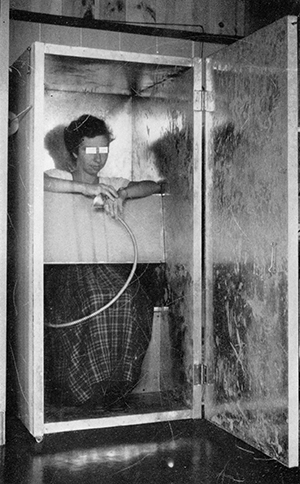From Wilhelm Reich’s book The Orgone Energy Accumulator: Its Scientific and Medical Use, Orgone Institute Press, Rangeley 1951, p. 12 and 16-19
What is an orgone energy accumulator?
The Orgone Energy Accumulator is an instrument assembled and materially arranged in such a manner that life energy, present in the atmosphere of our planet, can be collected, accumulated, and made usable for scientific, educational and medical purposes.

An orgone energy accumulator with chestboard and shooter in use.
Who invented the orgone energy accumulator?
The Orgone Energy Accumulator (oea) was invented by the research scientist and physician, Wilhelm Reich, M.D., during 1940 in the usa.
Orgone energy accumulator
Until the discovery of the above, properties of the atmospheric orgone energy, its function—usually called “static”—has remained inoperable. As a matter of fact, it was only a disturbing nuisance in electronics, aeronautics, radio technology, etc. With the invention of the orgone energy accumulator it became usable.
In order to use the atmospheric energy it has first to be collected and concentrated. It is collected by a certain arrangement of organic and metallic material. The efficiency of the collection and concentration of atmospheric orgone energy life energy) depends:
- On the kind of non-metallic material used; there are good (plastic) and bad (wood) absorbers.
- On the kind of metal used; only iron can be used for medical
- On the degree of the average humidity in the atmosphere ; water eagerly attracts orgone energy, and vice verca. Therefore, the drier the climate the better the accumulation; 40-50% relative humidity is a good condition for orgone energy concentration.
- On the geographic latitude where the accumulation is taking place; the closer to the equator the more efficient is the absorption; a 2-fold orgone energy accumulator is more efficient in Israel than in London.
- On the, altitude; the higher above sea level, the freer is the atmospheric energy from gaseous admixtures and the better its functioning.
- On the number of layers used in the accumulating device: “one layer” consists actually of two layers, one of organic matter on the outside, the other of metallic matter on the Organic matter absorbs and holds, while metal attracts and reflects orgone energy quickly. It is, therefore, obvious that by layering the accumulator always with organic matter toward the outside and metallic toward the inside, a direction is given to the orgone energy with a potential (orgonomic potential) directed from the outside toward the inside.
- On the closeness of the inner walls to the organism within the accumulator. The closer the surface of the living organism to the metal wall the stronger the effect of the orgone irradiation.
- On the number of accumulators present in a room or in a building; the more accumulators, the higher the atmospheric charge in the room and the greater the effects within the single accumulator. The presence of an Orgone Energy Room greatly enhances the total charging process.

The metal lined orgone energy dark room at Orgonon.





